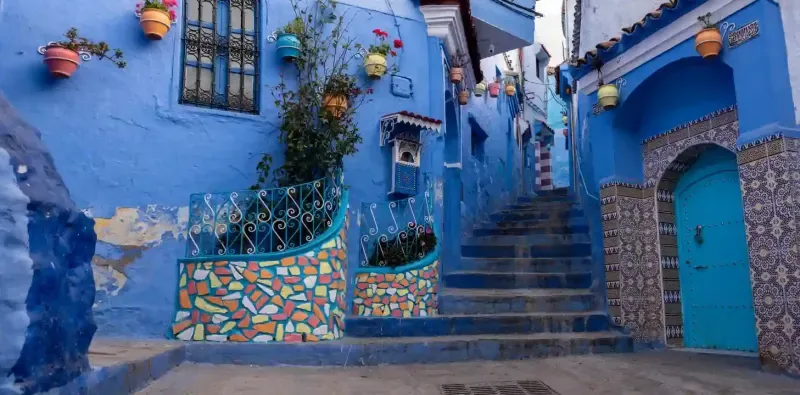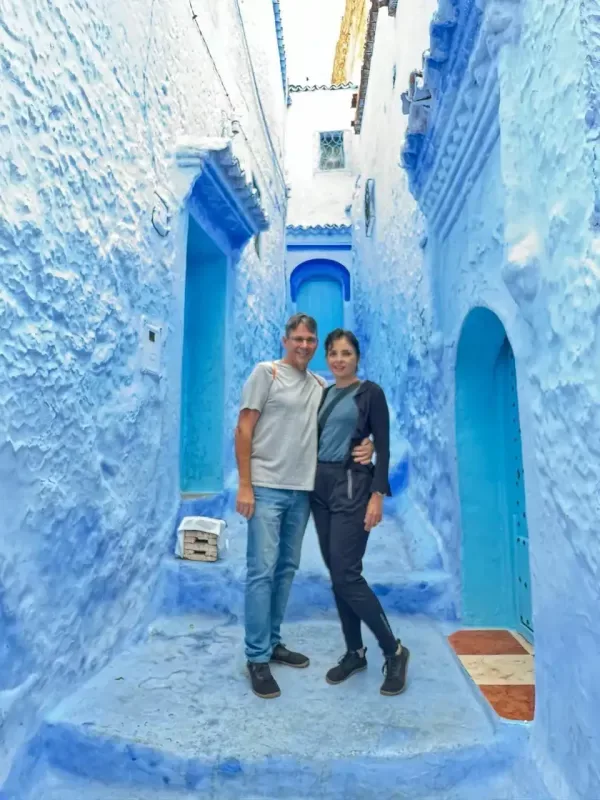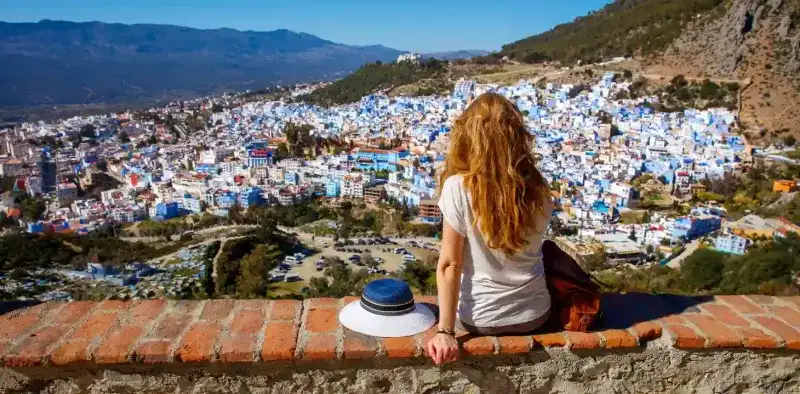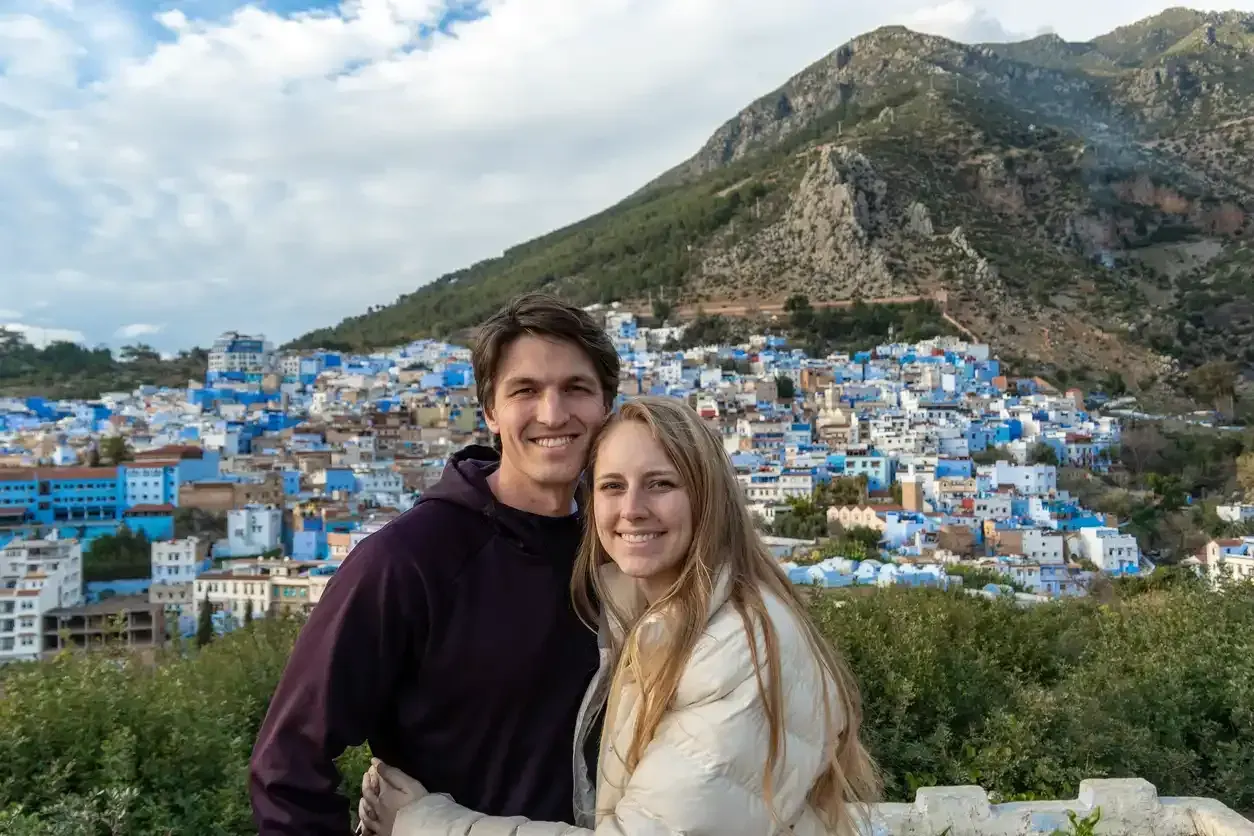Streets painted in every conceivable shade of blue, from delicate azure to profound indigo, define the extraordinary character of Chefchaouen, a mountain settlement that has captivated travelers for centuries. Positioned strategically at the base of the Rif Mountains in northern Morocco, this remarkable destination earned its designation as "The Blue Pearl" through the distinctive cobalt-hued facades that distinguish it from every other city across the globe.
Historical records document Chefchaouen's establishment in 1471 as a defensive kasbah, specifically constructed to repel Portuguese invaders. This mountain stronghold has since evolved into Morocco's most photographically celebrated blue city, maintaining a current population of 46,168 residents as of 2024. The settlement provides a markedly more relaxed atmosphere than the energetic pace found in Marrakech or Fes. The characteristic blue coloring of buildings dates precisely to the 1930s, when Jewish refugees established their community within this mountain refuge.
The city's attractions encompass the historic Medina, centered around the significant Uta Hammam Square, alongside bustling souks where artisans sell handcrafted woolen textiles colored with authentic natural indigo. Nature enthusiasts will find the Chefchaouen waterfall expedition to Akchour particularly rewarding, covering approximately 12-13 kilometers on the complete round-trip journey.
This comprehensive guide presents essential knowledge about this blue-painted marvel, examining the compelling historical origins of its distinctive coloration, exploring the significant attractions housed within its ancient defensive walls, and detailing the spectacular natural beauty that surrounds this mountain gem.
The story behind the Blue City of Morocco
Chefchaouen's distinctive azure palette represents one of Morocco's most intriguing architectural mysteries, with the origins of this chromatic tradition sparking scholarly debate and local folklore that continues to fascinate cultural historians and visitors alike.
Origins of the blue color tradition
Historical research reveals conflicting narratives regarding the precise genesis of Chefchaouen's blue-painted facades. Scholarly consensus points to two significant periods of Jewish settlement that shaped the city's distinctive appearance. The first wave occurred when Sephardic Jews fled the Spanish Inquisition in 1492, seeking sanctuary within this mountain fortress. These early settlers may have introduced their cultural practice of blue-painted dwellings to their adopted homeland.
However, ethnographic studies suggest the more widespread adoption of blue coloring occurred during the 1930s, when Jewish refugees escaping escalating European persecution established a more substantial community presence. Local testimonies from elder residents provide particularly revealing insights - they recall that initially, only the Jewish quarter (Mellah) displayed blue-painted structures, while the broader medina retained traditional white limestone facades.
The gradual expansion of blue coloring throughout the entire settlement occurred organically over subsequent decades, ultimately creating the monochromatic urban landscape that defines modern Chefchaouen.
Religious and cultural symbolism
Jewish religious tradition attributes deep spiritual significance to the color blue, connecting earthly existence to divine realms. This chromatic choice reflects the heavens above, encouraging residents to maintain spiritual awareness and proximity to the divine. The symbolic importance of blue appears throughout Jewish ceremonial objects, most notably in the sacred threads incorporated into traditional prayer shawls.
Muslim inhabitants who subsequently embraced this architectural practice interpret blue through their own cultural lens, associating the color with joy, serenity, and hopeful prospects. The psychological impact of these calming hues contributes measurably to the tranquil atmosphere that characterizes Chefchaouen's narrow passageways and residential quarters.
Practical reasons: heat and mosquitoes
Architectural functionality provides additional rationale for maintaining the blue tradition. The light-toned pigments effectively reflect solar radiation rather than absorbing thermal energy, creating naturally cooler interior environments during Morocco's intense summer periods.
Local environmental knowledge offers another compelling explanation for the blue walls' persistence. Community wisdom maintains that these painted surfaces repel mosquitoes through visual deception - the insects allegedly mistake the flowing, water-like appearance of blue walls for actual water sources, which they instinctively avoid despite their breeding proximity to moisture.
Contemporary residents honor this centuries-old tradition through biannual painting rituals, applying fresh blue coats twice each year, including the ceremonial renewal performed one month before Ramadan, ensuring Chefchaouen preserves its distinguished status as Morocco's beloved Blue Pearl.

Jewish refugees painted the city blue in the 1930s, as blue symbolizes heaven in Jewish tradition. Locals maintain the tradition today to attract tourists and preserve Chefchaouen's unique identity.
Yes! Chefchaouen is worth visiting for its stunning blue streets, relaxed vibe, and Instagram-worthy alleys. Perfect for 1-2 days between Fez and Tangier.
You can explore the blue medina, visit the Kasbah Museum, hike to the Spanish Mosque for sunset, shop for handicrafts, and trek to Akchour Waterfalls nearby.
Exploring the heart of Chefchaouen: The Medina
Winding passages through Chefchaouen's medina unfold architectural treasures and cultural heritage at every turn, each alleyway revealing centuries of Moroccan mountain life preserved within ancient stone walls. This historic quarter, protected by original defensive fortifications, contains the settlement's most significant monuments and artisanal traditions.
Place Uta el Hammam and the Kasbah
Place Uta el Hammam occupies the central position within the medina, functioning as the principal gathering space since its 16th-century construction. The cobblestone plaza derives its name from a traditional hammam (bathhouse) that once operated from its northwest corner, establishing this location as the community's social center. A mature tree anchors the square's center, offering natural shade where locals and visitors congregate throughout the day. The plaza's perimeter features traditional cafés and restaurants where patrons can enjoy mint tea while observing the daily rhythms of mountain life.
The formidable 15th-century Kasbah commands the square's southern edge, its clay-brown walls rising as a testament to Sultan Moulay Ismail's architectural vision. This historical fortress houses an ethnographic museum displaying regional textiles, traditional musical instruments, ceramic pottery, and period weaponry. The Portuguese Tower within the complex provides elevated perspectives across the blue-painted cityscape and the surrounding Rif Mountain peaks.
The Grand Mosque and its unique minaret
Chefchaouen's Grand Mosque stands adjacent to the Kasbah, representing the community's oldest and most significant religious structure. The mosque's construction in the 15th century was commissioned by the town founder's son, resulting in an architectural masterpiece distinguished by its exceptional octagonal minaret design. This geometric feature sets the structure apart from conventional Moroccan mosque architecture. While religious protocol restricts non-Muslim entry, the building's exterior craftsmanship warrants appreciation, particularly during the five daily calls to prayer that resonate throughout the azure-colored streets.
Chefchaouen souk and artisan crafts
Commercial activity flourishes throughout the medina, with particular concentration around Uta el-Hammam square and its dedicated craft center. The narrow thoroughfares contain workshops and retail spaces showcasing local craftsmanship – elaborately carved wooden furniture and doorways, vibrant Amazigh textiles and floor coverings, and household items crafted from regional materials. Artisans demonstrate their expertise with wool colored using traditional natural indigo processes, metalwork, leather goods, and ceramic production.
Instagram spots: Blue Street and Said's orange stand
Photography enthusiasts gravitate toward Derb El Assri (Callejon El Asri), which exemplifies Chefchaouen's most photogenic blue-painted street. The location's azure-colored walls, stepped architecture, and decorative ceramic vessels create compelling visual compositions. Said's orange juice stand nearby has gained recognition as another popular photography location, where the vendor's bright citrus fruits provide vivid color contrast against the blue architectural backdrop. Early morning visits before 9 am offer optimal lighting conditions and fewer crowds, when sunrise illumination creates dramatic effects across the painted surfaces.
Discover the Blue City of Morocco with our Morocco tour packages. From Chefchaouen’s blue alleys to Akchour’s waterfalls—book your adventure now!

Take a CTM bus from Fez (4 hours, $10), Tangier (2.5 hours, $7), or a shared grand taxi from Tetouan (1 hour, $5). Private drivers are also available.
Customize Your Dream Vacation!
Get in touch with our local experts for an unforgettable journey.
Plan Your TripNature escapes near Chefchaouen
The rugged Rif Mountains surrounding Chefchaouen present extraordinary natural landscapes that extend far beyond the city's celebrated blue architecture, offering adventurous visitors access to some of Morocco's most pristine wilderness areas.
Chefchaouen waterfall and Akchour hike
Akchour, located merely 30-45 minutes from the blue city, bears the poetic designation "Le Paradis Perdu" (the lost paradise) and features Morocco's most spectacular waterfall formations. The hiking route guides visitors through dense emerald forests that follow the path of a crystalline mountain river. Serious hikers can undertake the complete journey to the "Grande Cascade," which covers approximately 12-13 kilometers round trip and requires about 3-4 hours total. Those preferring shorter excursions will encounter smaller waterfalls after just 40 minutes of walking.
The trail reveals the remarkable "Pont de Dieu" (God's Bridge), a natural stone archway that rises 25 meters above the rushing river. Hikers should expect to cross the river using concrete stepping stones at several points, making waterproof footwear advisable. Small informal cafés dot the route, serving fresh orange juice and traditional tajine meals while providing perfect rest stops where visitors can cool their feet in the mountain stream.
Talassemtane National Park trails
Spanning an impressive 60,000 hectares of mountainous territory, Talassemtane National Park protects vital ecosystems throughout the Rif Mountain range. The park features carefully maintained trail systems that lead to destinations including Kalaa, Tissouka Mountain, Akchour, and Azilane. Cedar, fir, and pine forests create the park's distinctive character while providing habitat for endangered Barbary macaques—primates found nowhere else except Morocco, Algeria, and Gibraltar.
Experienced mountaineers can attempt the demanding ascent to Jbel Lakraa, which reaches 2,159 meters above sea level and provides sweeping panoramic views extending to the Mediterranean coastline. The park accommodates both day hikers and those seeking extended wilderness experiences through overnight stays in traditional mountain gites (guesthouses).
Spanish Mosque viewpoint at sunset
The Spanish Mosque presents a more accessible yet equally spectacular natural viewing experience from its elevated position overlooking Chefchaouen. Constructed during the 1920s but never consecrated for religious purposes, this restored structure commands the finest vantage point for observing the entire blue city. The moderate 3-kilometer round-trip ascent requires approximately 45 minutes of uphill walking, with numerous scenic stopping points for photography and rest along the route.
Sunset viewing from the Spanish Mosque creates an unforgettable spectacle as Chefchaouen's blue buildings glow beneath golden evening light while the traditional calls to prayer echo upward from the city below. The mosque's strategic southeastern orientation provides the ideal perspective for witnessing the transition from day to evening across Chefchaouen's azure urban landscape.

Yes, hand-holding is acceptable in tourist areas like Chefchaouen, Marrakech, and coastal cities. Avoid kissing in public - it's culturally inappropriate.
Planning your visit to Chefchaouen
Successful exploration of Morocco's celebrated blue mountain settlement demands careful preparation and understanding of local conditions. Strategic planning ensures optimal experiences within this ancient medina and the surrounding Rif Mountain landscapes.
Best time to visit the Blue City
Spring months (March-May) and autumn period (September-October) provide the most favorable conditions for exploring Chefchaouen, with temperatures maintaining comfortable ranges between 64°F to 77°F (18°C to 25°C). These seasons offer ideal weather for Medina exploration and mountain hiking activities. Summer months (June-August) present warmer conditions, with temperatures reaching 82°F to 90°F (28°C to 32°C), though the elevated mountain location makes heat more tolerable than coastal areas.
Winter months (November-February) deliver the most tranquil visiting experience, featuring daytime temperatures of 57°F to 61°F (14°C to 16°C). However, evening temperatures drop considerably to 39°F (4°C), requiring warm clothing preparation. December through February experiences the heaviest rainfall periods, potentially affecting outdoor activities.
Where to stay: inside or outside the Medina
Accommodations within the medina walls provide authentic immersion into Chefchaouen's historic atmosphere. Traditional riads and guesthouses feature rooftop terraces with panoramic views across the blue-painted cityscape. These locations require navigation through steep, narrow pathways with multiple staircases, presenting challenges for travelers with substantial luggage.
Accommodations positioned just beyond the medina boundaries offer enhanced accessibility while maintaining proximity to primary attractions. These establishments frequently provide contemporary amenities and easier vehicle access. Early reservation proves essential, particularly during peak visiting seasons, as Chefchaouen's popularity continues to grow.
Getting there: taxis, buses, and walking tips
Daily CTM bus services connect Tangier (the nearest major airport city) to Chefchaouen, requiring approximately 2.5 hours travel time at 65 MAD (USD 6.50). Routes from Fes extend to 4.5 hours duration, costing 80-120 MAD (USD 8-12).
The medina maintains complete pedestrian access, prohibiting all vehicle entry. Transportation from the bus station to Medina entrance involves a 25-minute uphill walk, or a petit taxi service for 15-20 MAD (USD 1.50-2.00).
What to pack for the terrain and weather
Sturdy walking footwear proves essential for navigating Chefchaouen's hillside terrain and cobblestone surfaces. Layered clothing accommodates temperature variations, particularly important during transitional seasons.
Summer visitors benefit from lightweight linen or cotton fabrics that provide cooling while maintaining respectful coverage of shoulders and knees according to local customs. Winter travelers require warm outer garments for chilly evening temperatures.
Essential accessories include compact day bags, quality sunglasses, and wide-brimmed hats for mountain sun protection. Waterfall excursions necessitate waterproof footwear and quick-drying fabrics, as certain trail sections require water crossings.
Casablanca has Morocco's largest Jewish population with approximately 2,000-2,500 Jews. You'll find active synagogues, a Jewish museum, and kosher restaurants there.
Conclusion
Chefchaouen represents an extraordinary testament to Morocco's diverse cultural heritage. This cobalt-colored mountain settlement, positioned within the dramatic Rif Mountain landscape, presents visitors with an unparalleled combination of architectural distinction, historical significance, and spectacular natural environments that continue to attract discerning travelers from across the globe.
Each narrow passageway within the blue-painted medina reveals layers of fascinating history. The distinctive azure facades, initially applied by Jewish refugees during the 1930s, function simultaneously as cultural monuments and practical adaptations to Morocco's challenging climate conditions. The Medina's commercial heart at Plaza Uta el-Hammam demonstrates centuries of continuous habitation, where the formidable 15th-century Kasbah and the architecturally unique Grand Mosque with its octagonal minaret create an impressive historical tableau.
The surrounding natural landscapes provide equally compelling attractions. Akchour's waterfalls and the extensive trail network within Talassemtane National Park offer adventurous visitors access to some of Morocco's most pristine mountain environments. The Spanish Mosque viewpoint delivers particularly memorable sunset panoramas, where the entire blue settlement appears illuminated against the dramatic mountain backdrop.
Successful visits require careful seasonal planning. The temperate conditions during spring and autumn months create optimal circumstances for both urban exploration and mountain hiking activities. Accommodation decisions—whether within the medina's traditional riads or in modern facilities beyond the ancient walls—significantly influence the overall experience of this distinctive destination.
Chefchaouen creates lasting memories for every visitor who experiences its unique atmosphere. The exceptional integration of remarkable architecture, profound cultural heritage, and outstanding natural beauty establishes an environment found nowhere else in North Africa. Departing from Morocco's Blue Pearl inevitably leaves travelers with vivid recollections of cobalt-painted alleyways, sweeping mountain panoramas, and the genuine warmth of Moroccan hospitality that beckons them to return to this singular corner of the Atlas region.
FAQs
Q1. What is the best time to visit Chefchaouen?
The ideal seasons to visit Chefchaouen are spring (March-May) and fall (September-October), when temperatures range from 64°F to 77°F (18°C to 25°C), perfect for exploring the medina and hiking nearby trails. Summer can be quite hot, while winter is cooler and sees the most rainfall.
Q2. What should I wear when visiting Chefchaouen?
Comfortable walking shoes are essential due to the hilly terrain. Wear lightweight, breathable clothing that covers shoulders and knees to respect local customs. For photos, consider wearing bright colors like yellows, oranges, pinks, or reds to contrast with the blue backdrop of the city.
Q3. How do I get to Chefchaouen?
From Tangier, you can take a CTM bus that takes about 2.5 hours. From Fes, the journey is around 4.5 hours. Once in Chefchaouen, the medina is entirely walkable. From the bus station to the medina entrance, you can either walk for about 25 minutes uphill or take a petit taxi.
Q4. What are some must-see attractions in Chefchaouen?
Key attractions include the blue-washed streets of the medina, Place Uta el Hammam and the Kasbah, the Grand Mosque with its unique octagonal minaret, and the vibrant souks. Don't miss the Spanish Mosque viewpoint for a spectacular sunset view over the city.
Q5. Are there any nature activities near Chefchaouen?
Yes, there are several nature escapes near Chefchaouen. You can hike to the Akchour waterfalls, explore trails in Talassemtane National Park, or take a shorter hike to the Spanish Mosque viewpoint. These offer beautiful landscapes and views of the surrounding Rif Mountains.

